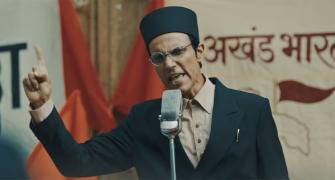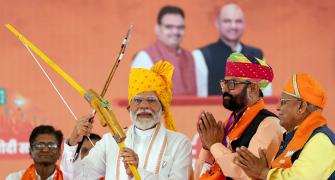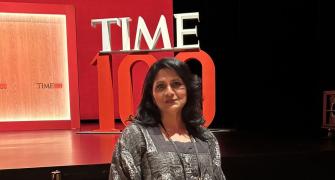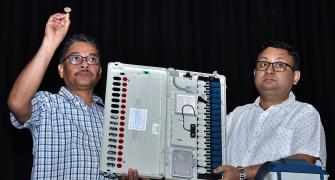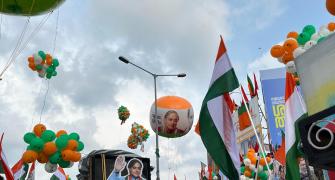Media and entertainment company Creative Eye looks for vertical growth by venturing into film production and animation with a handful of international projects in its kitty. It plans to produce soaps and social genres while retaining its focus on mythologicals which are its niche. The company, whose programming is valued around Rs 40 crore (Rs 400 million), has also made a successful foray into the South. Creative Eye posted a net profit of Rs 31 lakh (Rs 310 million) for Q403 compared with a loss of Rs 15 lakh (Rs 150 million) in Q402.
For FY03, net profit crawled up by just 1.36 per cent to Rs 1.46 crore (Rs 14.6 million) compared with Rs 1.44 crore (Rs 14.4 million) in FY02. The scrip hovers around Rs 15 levels on the BSE and trades at a P/E of 83x. Dheeraj Kumar, chief executive, speaks to Arun Rajendran about the company's plans and projections in the year ahead.
How has the shift to satellite channels affected Creative Eye?
The intellectual property rights of the programmes we do for Doordarshan remain with us. We can leverage upon the IP rights at a later stage as we have done with our mythologicals. This is an advantage we enjoy with DD.
Besides, we are used to DD's style of functioning. We have almost 2,400 hours of programming, and we own the entire IP rights to the same. Two years ago, PricewaterhouseCoopers had valued our programming at Rs 33 crore (Rs 330 million).
From then the value of our programming should have appreciated by at least Rs 8-9 crore (Rs80-90 million). Our serial Om Namah Shivay has been running five days a week on Sony after a highly successful run on DD. The serial has been shown in 11 countries across the globe. We have sold the musical, DVD and VCD rights. In fact, we have made a breakthrough by telecasting Sri Ganesh on Sony while its IP rights remain with us. I believe that IP rights are the future. One should never sell IP rights.
How has the company's southern foray been? What are the projections on this front?
Our southern foray has been very successful. The top two serials on Star Vijay -- Kalyani and Kavyanjali are made by us. The quality of our programmes could be gauged by the TRPs. Kavyanjali enjoys the highest rating at 13 TRPs while Kalyani is second with seven TRPs. Kavyanjali was produced by Balaji till the 92nd episode after which we took over. The ratings of the serial rocketed and we have completed over 300 episodes. From October onwards, we will have two more serials on Star Vijay.
The company has forayed into feature films. What are the projects in hand?
We have ventured into film production and animation films. We have signed Roger Christian, who directed films such as Battlefield Earth and Star Wars-Episode 1, The Phantom Menace, to direct an English language film for the world market.
The movie, to be launched in the third quarter of the current fiscal, is not a crossover film and has a supernatural element on the lines of The Sixth Sense. It is a $3 million movie and we have a partner who will be putting in almost 60 per cent of the equity. We will bear the balance 40 per cent. We have also launched a Rs 8 crore (Rs 80 million) 3D film Aabra Ka Daabra, targeted primarily at children, scheduled for release in April, 2004.
What is the progress on the 3D animation graphics project?
When you launch a 3D film, you incur a sizeable expense. You have to replace the normal screen with a special one for better luminance. Two additional lenses are also required for the projector. The total expenses will be around Rs 170,000 per theatre.
Expenses will be quite sizeable if too may theatres show the movie. We have developed a new technology 3D Plus which will allow 3D experience without spending a rupee on additional equipment. The technology will enable one to watch a 3D TV show on an analogue TV set.
The technology has impressed foreign firms and we have offers for our equipment from TV companies abroad. In 3D animation graphics, we are working for a project that has been approved by a US company. We have made a show-reel of seven minutes. The project would have a huge impact on our revenues in 2004.
The company has predominately been associated with mythologicals. Do you plan to change the programming mix?
Mythologicals are our niche. However, we also have alternate genres of programming. We are launching new social serials on Sony Star and DD. Kiran-Ek Umeed, a daily soap, will be launched on Sony while Khoobsoorat Hain Zindagi will be aired by Star. We are also having a soap Kya Beti Paraiya Dhan Hain on ETV. We are also launching five shows for DD in the social genre. In addition, another programme Nav Graha Shakti-Power of the Planets is being readied for an international launch and will probably be telecast on BBC.
How many hours of programmes are you making at present?
We have over 10 hours of programming per week. Sixty per cent of our programming is on DD while 40 per cent is on satellite channels. Satellite channels mainly offer one time gains against the milking of IP rights we do on DD. We have to do a balancing act. We make mythologicals primarily for DD while our soaps are mainly shown on satellite channels. Earlier, we had shifted about 80 per cent of our programming to satellite channels when DD penalised successful production houses by asking to buy extra time, which resulted in an escalation in telecast cost. However, we shifted right back when DD changed its policy.
How has the initial public offering amount been utilised? What is the company's cash position?
A part of the IPO amount has been used for setting up post-production high-definition studios and developing technology and other infrastructural requirement. We have Rs 16 crore (Rs 160 million) in cash. We will utilise it in film production and other ventures, keeping a minimum risk strategy in mind.
What are the risks you are facing? Does conditional access system offer any opportunities?
A policy change by channels or the information and broadcasting ministry could be a risk. If CAS is implemented, there would be a negative impact on channels. The initial nine months after implementation could be very bad. However, ad revenues would pour into free-to-air channels and DD. This may benefit us.
Depreciation for Q403 fell by over 300 per cent to Rs 46 lakh (Rs 4.6 million) from Rs 1.45 crore (Rs 14.5 million) in Q402. How do you explain the fall?
In December 2001, we had made a decision to take depreciation on brand value and the result was that depreciation for the whole of 2002 was taken Q402. After that we have been providing depreciation on brand value every quarter. This is the reason behind the discrepancy in the depreciation amount.
What is your outlook on the company's topline and bottomline?
We are very optimistic on our future prospects. We expect to double our revenues next year.

